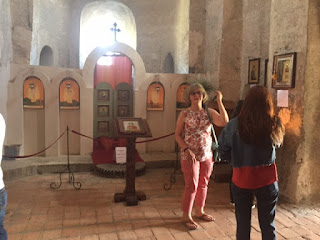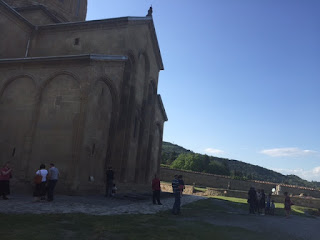Part Six, STILL June 4th.
Start with Part One here.
After lunch we headed to
Uplistsikhe, about an hour's drive from Mtskheta. Identified by archeologists as one of the
oldest urban settlements in Georgia, Uplistsikhe literally means "the
Lord's Fortress. " It dates back to the early Iron Age (1200- 600 B.C.), and
older by some archeologists' estimates, and to the Bronze Age (3000- 2400 B.C.). Some later structures were added during the Middle Ages,
or Medieval period, a thousand years from 500 A.D.-1500 A.D, which began with
the fall of the Roman Empire until the rise of the Ottoman Empire.
It was an important religious, political, and cultural center. Situated
above the Mtkvari River, the city stood
directly on the path of the old Silk Road and was a strategic and commercial
center. The Silk Road was used regularly
from 130 B.C. when trade from China was officially opened to the west, to 1453
A.D. when the Ottoman Empire boycotted trade with the west and closed the
routes.
The town was in its heyday as early as the 9th- 11th
century. It had a population of 20,000.
When Christianity came to Georgia in the fourth century A.D. in Mtskheta,
and later Tbilisi, Uplistsikhe declined in importance. However, Uplistsikhe remerged
as a principle Georgian stronghold during the Muslim conquest of Tbilisi in the
eighth and ninth centuries. The Mongols raids in the 13th century marked the
ultimate collapse of the town, and it was virtually abandoned except for an
occasional temporary shelter in times of foreign invasions. The Mongols invaded
Georgia in 1220 and again in 1231. At that time the Kingdom of Iberia included present
day Georgia, Armenia, and much of the Caucus countries, including all or parts
of Azerbaijan, Iran, Russia, and Turkey.
 |
| From the internet |
Georgia fell under the domination of the Ottoman Empire in
the 15th century. During the 18th and 19th century, it transitioned from being
a mainly Iranian centered country to a Russian annexation.
Several of the most vulnerable areas were completely
destroyed by an earthquake in 1920. The stability of the monument remains
tenuous.
 |
| From the internet |
 |
| From the internet |
The living quarters and areas for communal purposes occupy a cliff of almost 2o acres. They are connected by steps carved into the stone. The majority of the caves are devoid of decoration. There is a large central meeting hall has coffered tunnel-vaulted ceiling and a palace complex. The natural sandstone made it easy to create carvings of intricate patterns.
 |
| From the internet |
There is a basilica from the 6th century, and a three-church
basilica built out of brick in the 9th and 10th centuries. Later churches were added
during the medieval period.
When we visited the National Museum in Tbilisi, we saw many
of the ancient artifacts discovered from the archeological excavations, such as
gold, silver, bronze jewelry, and ceramics and sculptures.
In ancient times, there were up to 700 caves, but today,
only 150 have endured.
 |
| This head-hurting map illlustrates the emormity and complexity of the site, |
After leaving Uplistsikhe, we stopped briefly at another church. I am sorry I can't remember the name. (Those names were pretty tricky!) We drank "holy water" from a spring, and I didn't even fear I might get sick. I felt protected and inviceable.
We are still on day one! It was hard to believe we had gotten off the plane in Tbilisi on this same date, just after midnight.
Next stop, a more personal story, dinner with Roma's family.
Continue with Part Seven.
Next stop, a more personal story, dinner with Roma's family.
Continue with Part Seven.














No comments:
Post a Comment